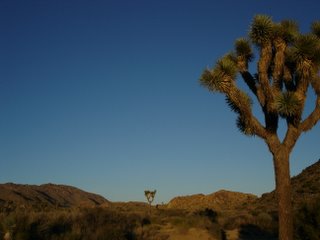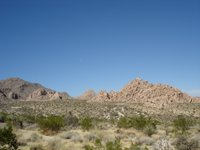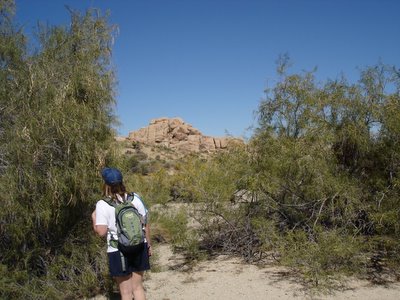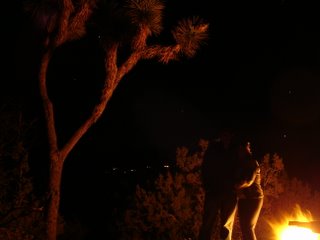
A few weeks ago (actually, the end of October, so several weeks ago), we spent a long weekend in the Palm Springs/Joshua Tree area of Southern California. I'm not sure what we were expecting, but it was a very intersting trip!
First of all, before we got to Joshua Tree, we spend the day in Palm Springs - better known as "God's Waiting Room" due to the overwhelming number of old people. The place is a desert oasis, if you're definition of refuge consists of golf courses and "homes for active seniors." I was expecting something like Rodeo Drive in the desert, but it was more like Del Boca Vista. The only thing that wasn't unexpected was the heat - which I'll quantify as "pretty damn hot." But hey, it's a dry heat.
 Joshua Tree Nat'l Park is about an hour's drive from Palm Springs (which is about 2 hours from LA) through the southern part of the vast and inhospitible Mojave Desert. Well, it's vast, but there are about 4 small towns along the way, including Yucca Valley and Twentynine Palms.
Joshua Tree Nat'l Park is about an hour's drive from Palm Springs (which is about 2 hours from LA) through the southern part of the vast and inhospitible Mojave Desert. Well, it's vast, but there are about 4 small towns along the way, including Yucca Valley and Twentynine Palms.Joshua Tree NP consists of several different ecosystems, and has elevations ranging from 500 to 5,000 feet. The northern desert is characterized by stands of spike-like ocotillo plants and “jumping” cholla cactus. The northern part of the park contains the habitat of the Joshua tree. And, the western most part of the park, above 4,000 feet, provides habitat for juniper and pinyon pine.
The trip was fairly uneventful, but it was interesting to see that the desert is nothing like the stretches of sand dunes that us East Coasters are led to believe. There are tons of plants and animals, and suprisingly, lots of water. Browse through the pictures below and see the diversity for yourself.


Sarah getting a closer look at some of the desert vegitation in this seasonal stream. Bird life was very plentiful in the park, and this area was also full of bugs, lizards and other creatures.

Some of the rocky outcroppings that make Joshua Tree such a destination for rock climbers.
 The Joshua tree "forests" looked like orchards. The trees were almost perfectly spaced, and appeared to be in rows that were planned and designed.
The Joshua tree "forests" looked like orchards. The trees were almost perfectly spaced, and appeared to be in rows that were planned and designed. Sarah, piloting our intrepid Sebring convertible through the desert.
Sarah, piloting our intrepid Sebring convertible through the desert.
 Probably the most disturbing image of the trip was the smog cutting through the Palm Springs valley. According to the guide, there is one pass through the mountains east of Los Angeles that acts like a funnel and sucks the LA fog into Palm Springs and Joshua Tree NP.
Probably the most disturbing image of the trip was the smog cutting through the Palm Springs valley. According to the guide, there is one pass through the mountains east of Los Angeles that acts like a funnel and sucks the LA fog into Palm Springs and Joshua Tree NP.
 In the middle of the park, there is a man-made lake, created by ranchers back in the good old days to water their grazing cattle. There is much more water in the desert that we ever imagined - you just need to know where to look.
In the middle of the park, there is a man-made lake, created by ranchers back in the good old days to water their grazing cattle. There is much more water in the desert that we ever imagined - you just need to know where to look.

Does Sarah ever follow directions?
 Under the stars and the Joshua trees at our luxury campground accomodations.
Under the stars and the Joshua trees at our luxury campground accomodations.



